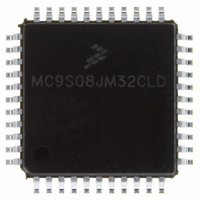MC9S08JM32CLD Freescale Semiconductor, MC9S08JM32CLD Datasheet - Page 324

MC9S08JM32CLD
Manufacturer Part Number
MC9S08JM32CLD
Description
IC MCU 8BIT 32K FLASH 44-LQFP
Manufacturer
Freescale Semiconductor
Series
HCS08r
Datasheet
1.MC9S08JM32CLD.pdf
(388 pages)
Specifications of MC9S08JM32CLD
Core Processor
HCS08
Core Size
8-Bit
Speed
48MHz
Connectivity
I²C, LIN, SCI, SPI, USB
Peripherals
LVD, POR, PWM, WDT
Number Of I /o
33
Program Memory Size
32KB (32K x 8)
Program Memory Type
FLASH
Ram Size
2K x 8
Voltage - Supply (vcc/vdd)
2.7 V ~ 5.5 V
Data Converters
A/D 8x12b
Oscillator Type
External
Operating Temperature
-40°C ~ 85°C
Package / Case
44-LQFP
Processor Series
S08JM
Core
HCS08
Data Bus Width
8 bit
Data Ram Size
2 KB
Interface Type
SCI/SPI
Maximum Clock Frequency
24 MHz
Number Of Programmable I/os
33
Number Of Timers
8
Maximum Operating Temperature
+ 85 C
Mounting Style
SMD/SMT
3rd Party Development Tools
EWS08
Development Tools By Supplier
DEMOJM, DEMOJMSKT, DEMOFLEXISJMSD, DEMO9S08JM16
Minimum Operating Temperature
- 40 C
On-chip Adc
8-ch x 12-bit
Lead Free Status / RoHS Status
Lead free / RoHS Compliant
Eeprom Size
-
Lead Free Status / Rohs Status
Lead free / RoHS Compliant
Available stocks
Company
Part Number
Manufacturer
Quantity
Price
Company:
Part Number:
MC9S08JM32CLD
Manufacturer:
Freescale Semiconductor
Quantity:
1 948
Company:
Part Number:
MC9S08JM32CLD
Manufacturer:
Freescale Semiconductor
Quantity:
10 000
- Current page: 324 of 388
- Download datasheet (5Mb)
Universal Serial Bus Device Controller (S08USBV1)
17.4.6.2.2
Reset can wake a device from the suspend state.
17.4.6.2.3
The USB device can send a resume event to the host by writing to the CRESUME bit. Firmware must first
set the bit for the time period required by the USB Specification Rev. 2.0 (Section 7.1.7.7) and then clear
it to 0.
17.4.7
The module supports multiple types of resets. The first is a bus reset generated by the USB Host, the
second is a module reset generated by the MCU.
17.4.7.1
At any time, the USB host may issue a reset to one or all of the devices attached to the bus. A USB reset
is defined as a period of single ended zero (SE0) on the cable for greater than 2.5 μs. When the device
detects reset signaling, it resets itself to the unconfigured state, and sets its USB address zero. The USB
host uses reset signaling to force one or all connected devices into a known state prior to commencing
enumeration.
The USB module responds to reset signaling by asserting the USBRST interrupt in the INTSTAT register.
Software is required to service this interrupt to ensure correct operation of the USB.
17.4.7.2
USB module resets are initiated on-chip. During a module reset, the USB module is configured in the
default mode. The USB module can also be forced into its reset state by setting the USBRESET bit in the
USBCTL0 register. The default mode includes the following settings:
324
•
•
•
a resume from low-power suspend. This will trigger an asynchronous interrupt to wake the CPU
from stop3 mode and resume clocks to the USB module.
Interrupts masked.
USB clock enabled
USB voltage regulator disabled
Resets
USB Bus Reset
USB Module Reset
As a precaution, after LPRESF is set, firmware must check the state of the
USB bus to see if the K-state was a result of a transient event and not a true
host-initiated resume. If this is the case, then the device can drop back into
stop3 if necessary. To do this, the RESUME interrupt can be enabled in
conjunction with the USBRESMEN feature. Then, after LPRESF is set, and
a K-state is still detected approximately 2.5 µs after clocks have restarted,
firmware can check that the RESUMEF interrupt has triggered, indicating
resume signaling from the host.
USB Reset Signaling
Remote Wakeup
MC9S08JM60 Series Data Sheet, Rev. 3
NOTE
Freescale Semiconductor
Related parts for MC9S08JM32CLD
Image
Part Number
Description
Manufacturer
Datasheet
Request
R
Part Number:
Description:
Manufacturer:
Freescale Semiconductor, Inc
Datasheet:
Part Number:
Description:
Manufacturer:
Freescale Semiconductor, Inc
Datasheet:
Part Number:
Description:
Manufacturer:
Freescale Semiconductor, Inc
Datasheet:
Part Number:
Description:
Manufacturer:
Freescale Semiconductor, Inc
Datasheet:
Part Number:
Description:
Manufacturer:
Freescale Semiconductor, Inc
Datasheet:
Part Number:
Description:
Manufacturer:
Freescale Semiconductor, Inc
Datasheet:
Part Number:
Description:
Manufacturer:
Freescale Semiconductor, Inc
Datasheet:
Part Number:
Description:
Manufacturer:
Freescale Semiconductor, Inc
Datasheet:
Part Number:
Description:
Manufacturer:
Freescale Semiconductor, Inc
Datasheet:
Part Number:
Description:
Manufacturer:
Freescale Semiconductor, Inc
Datasheet:
Part Number:
Description:
Manufacturer:
Freescale Semiconductor, Inc
Datasheet:
Part Number:
Description:
Manufacturer:
Freescale Semiconductor, Inc
Datasheet:
Part Number:
Description:
Manufacturer:
Freescale Semiconductor, Inc
Datasheet:
Part Number:
Description:
Manufacturer:
Freescale Semiconductor, Inc
Datasheet:
Part Number:
Description:
Manufacturer:
Freescale Semiconductor, Inc
Datasheet:











